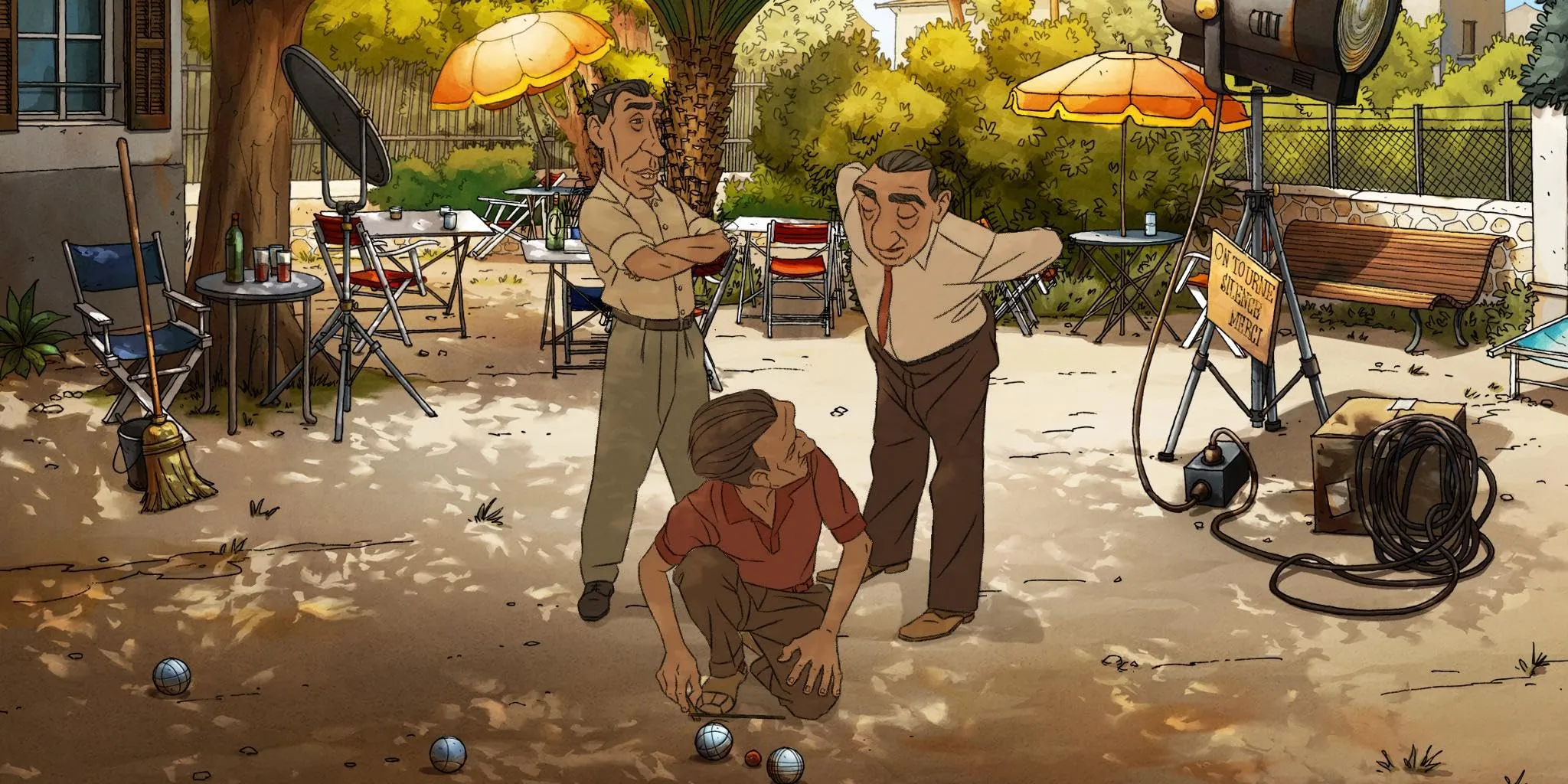Late afternoon light filters through a sparsely attended Parisian theatre as an elderly Marcel Pagnol, pen in hand, hesitates before a blank page—only to be nudged onward by the mischievous grin of his childhood self. That moment sets the tone for Sylvain Chomet’s animated biopic, in which the celebrated playwright-turned-filmmaker revisits his life through the eyes of both age and youth.
Chomet, best known for his gentle affection in Triplets of Belleville and The Illusionist, here offers a tender homage to one of France’s literary giants, tracing Pagnol from the sunbaked hills of Provence to the pre-war cafés of Paris.
The film marries hand-drawn linework with watercolor atmospheres, moving between the gray cobblestones of the city and the golden fields of home. We meet Pagnol at a crossroads: his latest play has stalled and he’s agreed, almost reluctantly, to serialize his memoirs for a fashion magazine.
As his younger self materializes to guide him, Chomet invites viewers into the creative process of memory itself. Through this framing device, the story unfolds as a conversation between what has been lived and what survives on the page, offering modern audiences a handcrafted journey into the life of a cultural titan.
Weaving Past and Present
The film opens with Pagnol in 1956, summoned by a magazine editor to distill six decades into serial installments—a simple assignment that blossoms into a full-scale voyage. Each chapter springs to life as a flashback: his childhood in a Provencal village where early curiosity meets maternal warmth; the lonely days teaching English in Paris, when his wife’s frustration drives her away; the breakthrough of his 1927 play Topaze; and the leap into cinema that brings him face-to-face with new audiences and new dangers under German occupation.
Chomet treats father-and-son versions of Pagnol as equals in storytelling. The older, world-weary writer pauses to reflect; the spirited boy prods him forward with childlike exuberance. Key turning points include the first taste of public praise, the sting of professional exile during wartime, and the complicated romances with actresses who become both muses and companions.
All the while, Pagnol’s late mother drifts through crucial moments as a guiding apparition, and three leading ladies—Orane Demazis, Josette Day, Jacqueline Bouvier—reveal how love and art intertwine. The narrative jumps swiftly between eras, slowing only to linger on moments of creative revelation and emotional reckoning.
Lines, Color, and Texture
Chomet’s animation unfolds like a vintage graphic novel brought to life. Figures are outlined in crisp black strokes, recalling the classic Franco-Belgian comic school, while backgrounds wash in autumnal grays and the sun-dappled yellows of Provence. In Paris scenes, narrow alleys and café terraces feel both lived-in and gently romanticized; in homecoming sequences, poplar trees and olive groves glow with nostalgic clarity.
Character movement combines subtle realism with occasional comic exaggeration. Pagnol’s features shift effortlessly from furrowed concentration to wonder. Supporting roles, from officious publishers to garrulous neighbors, are animated with broad gestures and expressive eyes. Vintage film excerpts slip seamlessly into the drawn frames, reworked with grain and sepia tones so they feel part of the same tapestry.
Unexpected flourishes—talking animals that squawk, bark or bleat encouragement—add playful interruptions, though they verge on whimsical distraction at times. Sound design embraces ambient layers: the hum of cicadas, rustle of newsprint, echo of footsteps on stage. A delicate musical score weaves through, punctuating both triumph and melancholy without overwhelming the gentle rhythms of memory.
Remembering and Becoming
At its heart, A Magnificent Life asks how artists shape their own stories—and how those stories endure. Chomet explores memory as both sanctuary and challenge. Pagnol’s late-career struggles remind us that creative flame can dim, yet reignite when fed by passion for place and purpose. Scenes of wartime resistance speak to an artist’s refusal to yield identity, even under occupation.
The film traces Pagnol’s multiple reinventions—teacher, playwright, director, novelist—as acts of resilience. His mother’s voice echoes in moments of self-doubt, underscoring how familial bonds fuel artistic daring. Romances with his leading ladies illustrate the fine line between devotion and disappointment when love intertwines with ambition.
Comic relief surfaces in animal cameos and witty asides—but these light touches heighten the sting of loss, from his mother’s death to the erosion of public acclaim. By film’s end, viewers are left dwelling on how memory and identity intertwine—and whether the stories we tell can outlast both time and obscurity.
A Magnificent Life premiered at the 2025 Cannes Film Festival on May 17, 2025, in the Special Screenings section. It is scheduled for theatrical release in France on October 15, 2025.
Full Credits
Director: Sylvain Chomet
Writer: Sylvain Chomet
Producers: Ashargin Poiré, Valérie Puech, Aton Soumache, Lilian Eche, Eric Goossens
Cast: Laurent Lafitte, Géraldine Pailhas, Thierry Garcia, Anaïs Petit, Vincent Fernandel, Véronique Philipponnat, Sophie Maréchal, Olivia Gotanègre, Shane Attwooll, Noa Staes, Elsa Pérusin, Lohen van Houtte, Martin Meersman, Elodie Barthels, Flora Montgomery, Matthew Gravelle, Lu Corfield, Jonathan Keeble, Celyn Jones, Jess Nesling
Director of Photography (Cinematographer): Elric Lefeuvre
Editors: Samuel Denou, Mario Houles, Julie Salon
Composer: Stefano Bollani
The Review
A Magnificent Life
A Magnificent Life is a lovingly crafted tribute that balances heartfelt nostalgia with inventive animation, offering an intimate look at Marcel Pagnol’s creative journey. While its whimsical animal interludes occasionally vie for attention, Sylvain Chomet’s meticulous design and the emotional interplay between past and present make for a moving exploration of memory and legacy.
PROS
- Gorgeous, hand-drawn animation with rich period detail
- Warmly nostalgic tone that humanizes Marcel Pagnol
- Inventive frame story pairing older and younger selves
- Lush sound design and evocative score
- Insightful exploration of artistic reinvention
CONS
- Talking-animal asides can feel distracting
- Pacing occasionally rushes through key events
- Whimsical flourishes sometimes undercut emotional depth
- Limited appeal for audiences unfamiliar with Pagnol’s work
